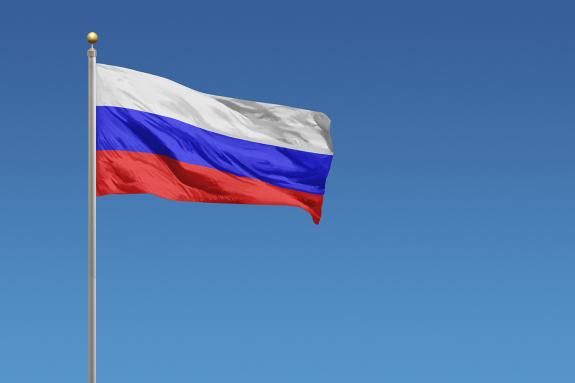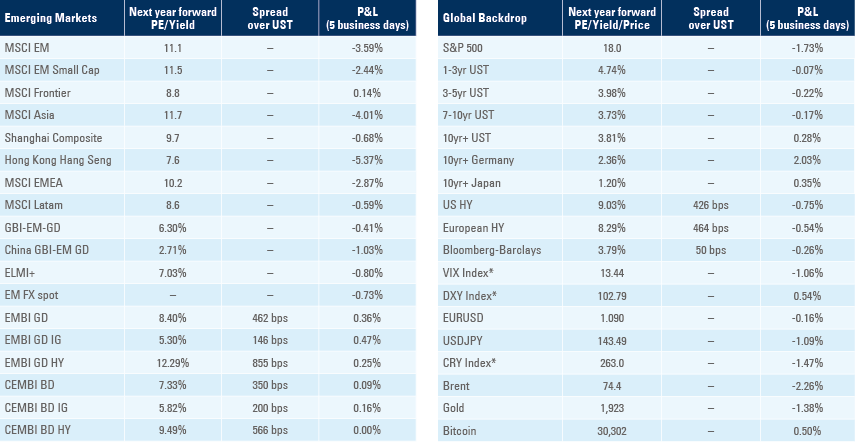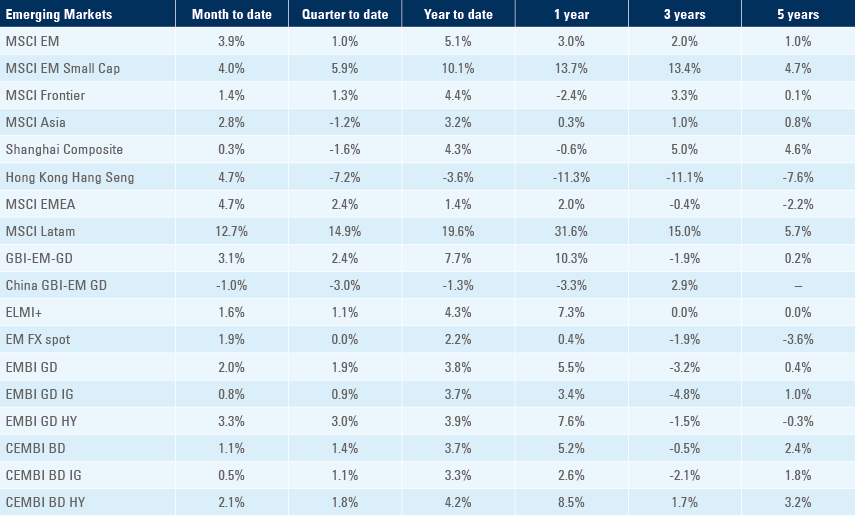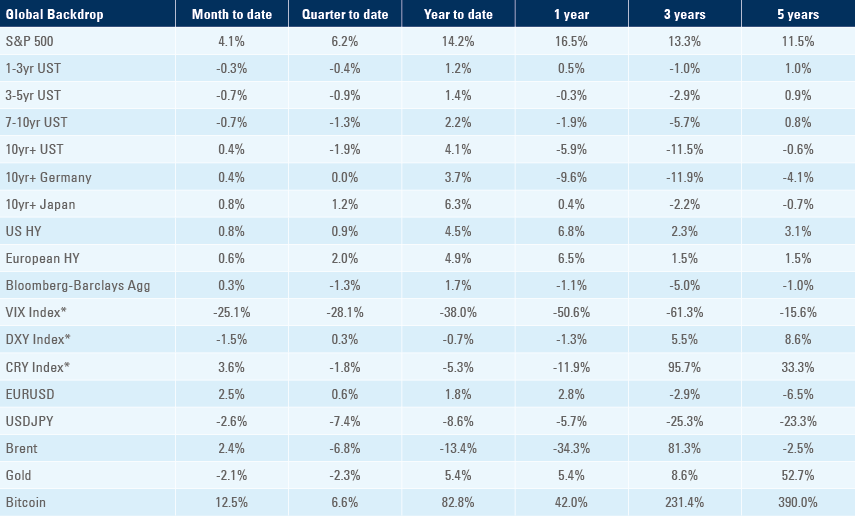
A failed coup in Russia, a political coup in Argentina, and a debt deal in Zambia
In Russia, Putin may have thwarted warlord Prigozhin’s coup attempt, but his leadership has been shaken. Argentina’s Economy Minister Massa clinched the job of presidential candidate for the centre-left Peronist bloc ahead of presidential primaries in August. Pakistan announced another round of economic reform to secure overdue International Monetary Fund (IMF) funds. Zambia reached a maiden ‘Common Framework’ debt restructuring deal that provided significant debt relief. Türkiye’s newly appointed central bank governor treaded a cautious path in her first interest rate hike decision.

Geopolitics
Russia botched coup d’état
Wagner’s Group Yevgeny Prigozhin, who has been fighting side-by-side with the Russian Army in Ukraine, shifted sides and marched his troops to Moscow. The Wagner Group is a ‘mercenary’ army which have been fighting as covert Russian forces across countries in disarray such as Libya, Syria, and Mali. Wagner’s key objective was to take control and explore key natural resources (oil fields, mines, etc.) to pay their army and patrons, either partnering with the existing government, or with other local forces challenging the government. They have been a key player across Africa for more than a decade, fighting Western-backed forces and changing the balance of power in places where they took an interest. With the Ukrainian war, Prigozhin personally recruited many fighters from Russian prisons to fight in Ukraine.
Over the last month, Prigozhin has been lambasting Russian leadership for their incompetence in managing the war, sending troops to the front line without sufficient ammunition, for example. Last Friday night, Prigozhin heavily criticised the leadership, including Putin, on a Telegram video and marched part of his troops first to Rostov-on-Don, the closest large military basis near Ukraine, and then towards Moscow, passing through another key military checkpoint in Voronezh. He was unchallenged at both key checkpoints, suggesting he had the support of high echelon members of Russia’s army, if not from the Kremlin itself. For a few hours, it felt like a showdown in Moscow was close Prigozhin announced he’d reached a deal intermediated by Belarussian President Alexander Lukashenko and Türkiye’s Recep Tayyip Erdogan.
The whole incident was unexpected and almost farcical, in our view. At times, it was possible to think we were living in a once-in-a-century event, as the fall of the Romanov dynasty took place in 1917 when Russian low-rank army leaders and soldiers turned against the Tsar. However, it felt unlikely for a full-blown general mutiny to erupt. Prigozhin is seen to be an uncharismatic character who does not enjoy popular support. Moreover, while the Russian population is starting to suffer from war duress, the situation does not seem comparable to 1917, when food rationing was severe, leading to widespread poverty.
That said, this does not appear to have been a staged or fake coup d’état. For Putin to address the nation like he did, with what could be interpreted as defiant but scared body language, something had clearly gotten out of his control. Ultimately, very few people close to the Kremlin will know the full extent of the situation, but the best thesis in our opinion was been that a large group of Wagner’s soldiers were attacked and killed by the Russian military in a position where Prigozhin was supposed to be himself. Sensed his campaign of criticism against Russian leadership had put him in the firing line, Prigozhin decided to go all-in, determined to storm into Moscow. We believe, his only trump card would have been for the Russian army to have switched to his side. When he got close to Moscow, realising his position was very tenuous, we think he decided to accept the deal proposed by Lukashenko.
This thesis gained strength when, on Saturday evening, the Kremlin announced Prigozhin would be moving to Belarus with local commentary suggesting the Wagner Group would be moving alongside, bringing the proxy battalions in Africa, Libya, Syria, and other places under Belarussian control. This was hardly a victory for the man that just a few hours before was trying to take power in Russia, and highlighted his position of weakness. At the time of writing, there have been no announcements of any change in the higher echelons of the Russian military, although it is possible changes will happen within the next few weeks and months to maintain Putin’s position of strength.
What are the main conclusions? First, we believe, this was probably good for Ukraine, at least in the short-term as the morale of the Russian military was dented while the morale of the Ukrainians was boosted by the bizarre events. This may yet change, should Putin decide to shift the incompetent top echelon of his army and appoint more professional replacements. Several other deep-pocketed private groups are willing to conscript the well-trained Wagner group soldiers, but this will take time. Ukraine’s best bet would arguably be to accelerate its counteroffensive now that the enemy is under pressure.
Second, the Western press is full of articles anticipating the “beginning of the end” of the Putin regime. This may well be the case, particularly if he doesn’t manage to fix his military problems and ends up suffering a humiliating defeat. Nevertheless, we would caution that people living through the Russian military defeat to Japan in 1905 may have had the same impression, but it took another 12 years for their hopes to prove correct. When the change in leadership finally happened, it hardly led to redemption for the Russian people. Putin appears to be far better prepared than Tsar Nicholas II and, as best as we can tell, still has the support of a hard-core elite and the Russian population overall, which would likely prefer a strong leader than a bloody revolution. In this instance, the new leader would be a former criminal convict head of a mercenary army with no experience in politics, international relationships or managing a country as vast as Russia. We believe Putin is also likely to learn from his mistakes, strengthening the weak spots unveiled by the botched Prigozhin attempt to reach Moscow.
Lastly, this event may upset the balance of power in the countries where the Wagner Group operates. It is hard to predict how things will evolve, but there may be much less attention and resources given to these proxy conflicts, particularly if Putin is keen to weaken Prigozhin, as seems to be the case. This may not necessarily be positive for stability in these countries, but may provide an opportunity for a more legitimate regime to take control of their respective resources.
Emerging Markets
Asia
China: The People’s Bank of China cut its one and five-year Loan Prime Rates by 10 basis points (bps) to 3.55% and 4.2%, in line with consensus. The share of SWIFT payments in RMB increased to 2.5% in May from 2.3% in April, the highest level since January 2022.
Indonesia: Bank Indonesia kept its policy rate unchanged at 5.75%, in line with consensus.
Malaysia: The year-on-year (yoy) rate of consumer price index (CPI) inflation dropped 50bps to 2.8% in May, 20bps below consensus. Producer price inflation (PPI) is even lower at -3.0%, which means Bank Negara Malaysia is unlikely to hike policy rates any further, in our view. The trade surplus increased from MYR 12.6bn in April to MYR 15.4bn in May, significantly above consensus as both imports and exports increased.
Pakistan: Prime Minister Shehbaz Sharif met IMF’s Managing Director Kristalina Georgieva in Paris on the side-lines of the Global Financing Summit, to appeal the IMF to release the USD 1.1bn tranche pending since November last year, as the USD 6.5bn loan programme nears its scheduled expiry at the end of June. The next day, Pakistan changed its budget for the financial year starting on 1 July. Finance Minister Ishaq Dar announced new fiscal tightening measures designed to revive the stalled rescue package: Pakistan will raise a further PKR 215bn (USD 752 million) in new tax and cut PKR 85bn in spending, as well as other measures to shrink the fiscal deficit. Dar also culled restrictions on imports enforced last December in a bid to cut Pakistan’s current account deficit, which had been another IMF demand. In addition, the State Bank of Pakistan hiked interest rates by one percentage point to 22% at an emergency meeting on 26 June. All these measures are expected to ensure the release of the IMF funds in the coming weeks.
Philippines: The central bank kept its deposit and borrowing policy rates unchanged at 5.75% and 6.25% respectively, in line with consensus. The balance of payment deficit widened to USD 439m in May from USD 148m in April.
South Korea: Daily exports declined by a yoy rate of 2.0% in the first 20 days of June, a sequentially better result than 13.2% over the same period of May. Ship vessels surged 178% month-on-month (mom), according to Barclays’ estimates while semiconductor exports increased for the fourth consecutive month despite softer prices. Exports to China declined 12.5% yoy, while exports to the US rose 18.4% yoy.
Taiwan: Export orders declined by a yoy rate of 17.6% in May after -18.1% yoy in April, but the result came in slightly better than the -21.3% consensus.
Latin America
Argentina: Argentina has general elections on 22 October (possible run-off on the 19 November), but the key event to monitor is the PASO on 13 August. PASO stands for Primaries, Open (Abiertas), Simultaneous and Obligatory where all population votes for their preferred candidate, giving a full sample poll only two months ahead of the general election. Last weekend was the deadline for the registration of candidates and, surprisingly, Finance Minister Sergio Massa announced he will be the only candidate for the Union por la Patria (Peronists). One day before it seemed Cristina Fernández de Kirchner ally Eduardo de Pedro would dispute against former Buenos Aires Governor Daniel Scioli in the PASO. It highlights Massa’s political strength, who is probably the most pragmatic politician within the Peronists. Massa must be thinking two steps ahead as his odds of winning are minimal since his approval rate is only just better than President Alberto Fernandez. Massa could remain a key political force should Juntos por Cambio (JxC) nominate Horacio Larreta as candidate, and he wins the election. Larreta has been arguing that a national alliance including the pragmatic Peronists will be needed to implement the difficult structural reforms required to stabilise the economy. Standing in Larreta’s way is Patricia Bullrich, who seems to be outmanoeuvring Larreta in the regional political alliances by positioning herself closer to the far-right members of the JxC coalition. Her strategy is to position JxC to take votes away from the far-right candidate Javier Milei (from La Liberdade Avanza) who has benefited from general dissatisfaction with traditional political parties. A poll by Giacobbe Consultores has Milei as the most viable candidate, at least on paper, as he has the highest positive image at 37.0% (vs. Bullrich 36.0%, Larreta 14.5% and Massa’s 11.3%) and the second-lowest negative image at 42.5%, which is marginally higher than Bullrich with 39.5%, but much lower than Larreta’s 52.9% and Massa’s 63.9%. Milei’s main Achilles heel is lacking national support and his positive image has not been benefiting local politicians as all the candidates he’s backed on gubernatorial elections this year (several states anticipated their elections) have suffered humiliating defeats. Also, Milei does not have an economic plan and is unexperienced in national politics. To summarise, the Argentinian general election looks wide open. The best-case scenario would be a second round run-off between JxC and Peronists, as that would most likely bring JxC back to power and both candidates from the party are keen on implementing a front-load large fiscal consolidation to bring Argentina’s deficit (4% of gross domestic product (GDP)) to a balance in the first year, mostly by reducing subsidies. The risk is if Milei goes to the second round and momentum carries him to win the election as little is known of his economic team and plans, apart from the pledge to dollarise the economy, which would be very hard to do in a country with less than USD 2bn in net foreign exchange (FX) reserves. Nevertheless, last weekend’s developments were likely to be positive to the country’s risk premium, in our view, as it consolidates two out of three candidates in the pragmatic camp.
In other news, GDP growth rose by 0.7% quarter-on-quarter (qoq) and 1.3% yoy in Q1 2023, from -1.5% qoq and +1.9% yoy in the previous quarter, slightly below consensus, while the unemployment rate increased 60bps to 6.9% over the same period. The trade deficit widened to USD 1.2bn in May from USD 0.2bn in April. Exports rose by USD 0.4bn to USD 6.2bn, but imports surged USD 1.3bn to USD 7.4bn. The GDP expansion, despite the severe drought impacting exports of soybeans and corn, is most likely due to the large excess money supply, some of it finding its way abroad via imports, despite significant capital controls, as Argentinians try to protect their purchasing power. The distortion caused by excessive local supply of money and capital controls is reflected by the near 50% gap between the parallel ARS (515) and official ARS (253) exchange rate against the USD. Finance Minister Sergio Massa is asking the IMF to front-load disbursements to the country as the Central Bank of Argentina’s net reserves stand at precarious levels. The problem is that the IMF is unsatisfied with the lack of compliance to the programme targets, including the fiscal deficit, which has been deteriorating due to lower export duty revenues, again, caused by the drought. The IMF is likely to demand a significant currency depreciation to anticipate the disbursements. Even with further commitments from Argentina that will be a tall order, considering the precariousness of the economy and political uncertainties.
Brazil: The Governor of Brazil’s central bank, Roberto Campos Neto, again struck a hawkish tone when keeping its policy rate at 13.75% last week, despite much softer than expected inflation. Controlling the narrative is key for inflation expectations and Campos Neto is enjoying a year where economic activity is surprising to the upside (2023 GDP growth consensus at 1.8% today against less than 1% early in the year) as we expected, despite the massive monetary policy tightening. Nevertheless, the statement following the meeting suggested the central bank is near the beginning of the easing cycle. Tax collections declined to BRL 176.8bn in May from BRL 203.9bn in April, in line with consensus and seasonality.
Chile: The central bank kept its policy rate unchanged at 11.25%, but signalled rate cuts over forthcoming meetings, provided inflation keeps declining to benign levels. Last Friday, PPI posted a 4.3% deflation in the month of May, bringing the yoy rate of PPI inflation down to -9.0%.
Colombia: The economic activity proxy declined by a yoy rate of 0.8% in April from +1.5% yoy in March, below consensus at +0.2% yoy. The trade deficit narrowed to USD 875m in April from USD 1,085m in March.
Mexico: The central bank kept its policy rate unchanged at 11.25%, in line with consensus, and kept a hawkish tone suggesting policy cuts are not happening anytime soon as authorities see inflation converging to its 3.0% target (+1% tolerance) only in H2 2024. CPI inflation on the first 15 days of June was unchanged in mom terms for the second consecutive month, as the yoy rate of inflation declined 50bps to 5.2% over the period while core CPI was down 40bps to 6.9% yoy, both 10bps below consensus. The yoy rate of retail sales rose 130bps to 3.8% in April (consensus and prior month 2.5%).
Central Asia, Middle East, and Africa
Egypt: The central bank kept its policy rate corridor unchanged at 18.25% to 19.25%, in line with consensus. The trade deficit widened to USD 2.3bn in April from USD 2.0bn in March,
Ethiopia: The UK’s post-EU liberalisation of its trade rules, through its new Developing Countries Trade Scheme (DCTS), is set to deliver benefits for some emerging economies through lowering the costs of exporting to the UK. Ethiopia is one out of 37 African countries involved in the scheme, which is expected to aid it in boosting agricultural exports. Ethiopian goods already make up a fair amount of UK imports, totalling GBP 301m in Q4 2022, and this should increase on account of its zero-tariff deal with the UK. In the long run, this is a step in the right direction for Ethiopia’s trade position, helping it to bounce back from its previous suspension from the US African Growth and Opportunity Act.
South Africa: CPI inflation increased by 0.2% mom in May after 0.4% in April, bringing the yoy rate down 50bps to 6.3% which was 20bps below consensus, while core CPI declined by 10bps to 5.2%, in line with consensus.
Türkiye: The Central Bank of Türkiye hiked its policy rate by 650bps to 15.0%, significantly below than consensus for a 1,150bps hike to 20.0%. The statement accompanying the announcement emphasised the willingness to implement a gradual adjustment of policy rates and heterodox administrative measures that were implemented by the previous governor (now deputy governor). The TRY depreciated 6.4% on the week and is down 26% year-to-date, the worse performing currency in Emerging Markets (EMs) except for the ARS, while five-year credit default swaps (CDS) widened by 32.5bps to 512.5, still standing significantly lower than the 700bps hit after the first round of the recent presidential elections. The trade deficit widened to USD 12.5bn in May from USD 8.8bn in April, in line with consensus.
Zambia: In one of the few actual achievements of the summit for a New Global Financing Pact held last week in Paris, Zambia reached a long-awaited deal with its creditors to restructure USD 6.3bn in official debt. This was the first successful debt restructuring deal under the Group of 20 nations’ Common Framework that brings the traditional creditors in the Paris Club around the same negotiating table with China. The deal provides Zambia with an immediate principal and coupon holiday until 2026, when coupons payments start at 1% and for amortisation payments to restart very slowly. The effective maturity extension for the country’s official debt averages over 12 years, by our calculation. The deal also cements the role of the World Bank in the assessment of the debt sustainability and the payment schedule achieved under the Common Framework.
Central and Eastern Europe
Czechia: The central bank kept its policy rate unchanged at 7.0%, in line with consensus.
Hungary: The central bank kept its policy rate unchanged at 13.0%, in line with consensus. The yoy rate of average gross wage inflation declined to 15.7% in April from 16.9% in March, significantly lower than consensus at 18.0%.
Poland: PPI inflation dropped by 1.6% mom in May after -1.3% mom in April (revised from -0.7% mom), bringing the yoy rate down by 310bps to 3.1% in May, 140bps below consensus. The yoy rate of retail sales slowed to 1.8% in May from 3.4% yoy in April (consensus 2.7%), but industrial output improved to -3.2% yoy from -6.0% yoy over the same period.
Developed Markets
United States: Economic data was mixed with housing improving, but leading indicators deteriorating. Housing starts and building permits rose more than expected to 1.63k and 1.49k houses in May (1.4k consensus for both) from 1.34k and 1.42k, respectively. Existing home sales were stable at 4.3m in May (consensus 4.25m). The Conference Board Leading Economic Indicators (ten indicators that cover a wide range of economic activity) declined by 7.9% yoy, a level only seen during economic recessions since the beginning of the survey in 1960. The flash purchasing manufacturers index (PMI) for the manufacturing sector dropped 2.1 points to 46.3 and the service sector PMI declined 0.8 points to 54.1 in June, both below consensus. Continuing claims rose 13k to 1.785m in the week ending 10 June and initial claims were unchanged at 264k for the week ending 17 June. The current account deficit widened to USD 219bn in Q1 2023 from USD 216bn in Q4 2022.
United Kingdom: The Bank of England hiked its policy rate by 50bps to 5.0% as two members dissented in favour of the 25bps hike expected by consensus. The decision came after yet another worse-than-expected inflation report. CPI inflation surprised by rising 0.7% mom in May after 1.2% in April and unchanged at 8.7% yoy, but core CPI increased 30bps to 7.1% and Retail price index (RPI) inflation was down only 10bps to 11.3% yoy. The flash manufacturing PMI declined one point to 46.2 and the services PMI was down 1.5 points to 53.7 in June, both below consensus.
Japan: The yoy rate of CPI inflation declined 30bps to 3.2% in May, in line with consensus, but core CPI ex-fresh food and energy (core core CPI) rose 20bps to 4.3% over the same period, 10bps above consensus. The flash manufacturing PMI declined one point to 49.8 and services PMI dropped 1.7 points to 54.2 in June.
Eurozone: The Eurozone’s flash manufacturing PMI dropped one point to 43.6 and services PMI declined 2.7 points to 52.4. German manufacturing PMI was down 2.2 points to 41.0, the lowest level since Q2 2020.

